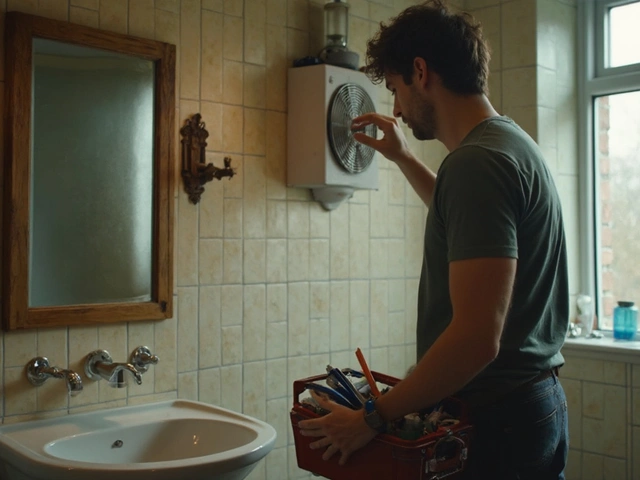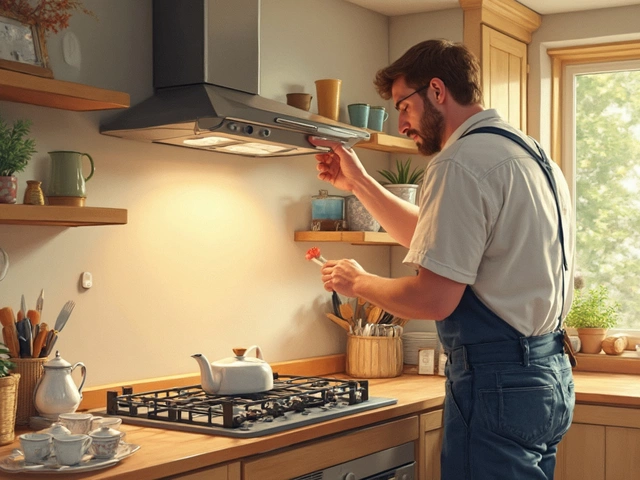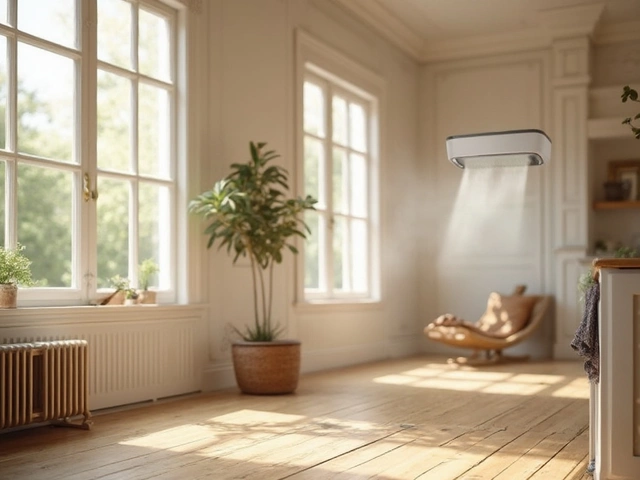Ever found yourself wondering if installing an extractor fan is within your DIY reach? You're not alone. Many folks are drawn to the challenge and the chance to save some cash. The good news is, with the right approach and a bit of patience, it can definitely be done.
Before getting started, think about why you want this fan. Whether it's about keeping the kitchen smoke in check or stopping mold in the bathroom, understanding your goal is key. It sets the stage for picking the right fan and planning your installation.
You'll need some basic tools and materials. A drill, a screwdriver, safety glasses, and possibly a saw should be on your checklist. Also, make sure you've got the right type of fan for the exhaust size.
In the next sections, we'll talk about the step-by-step process of installing the fan, along with some insider tips to make the job easier. Plus, I'll highlight some blunders to avoid, so you don't end up cursing the day you decided to go DIY!
- Why Install an Extractor Fan?
- Tools and Materials Needed
- Step-by-Step Installation Guide
- Tips and Common Mistakes
Why Install an Extractor Fan?
Ever stepped into a steamy bathroom or a smoky kitchen? It's not just annoying, but it could mean trouble for your home. An extractor fan is a small game-changer when it comes to keeping areas like the bathroom and kitchen fresh and safe.
Say Goodbye to Mold and Mildew
Left unchecked, moisture from showers or cooking can lead to mold and mildew. Not the kind of house guests you want, right? An extractor fan whisks away excess moisture, which keeps your walls and ceilings from growing those pesky mold spots. This can save you money on potential repairs and repainting down the line.Improve Air Quality
If you're big on cooking, you know the struggle with lingering smells and smoke. A powerful extractor fan handles unwanted scents and smoke, making sure your air stays fresh. You can cook up that curry without it smelling like it's been cooked up five times over.Compliance with Building Regulations
Now, this might sound boring, but having the right ventilation is an actual building code requirement. Especially in new kitchens and bathrooms, proper ventilation like an extractor fan isn't just a suggestion; it's something you gotta have for legal reasons.Here's a little fun fact: Many local building codes recommend having a fan that can replace the air in your room eight times an hour. That's a lot of fresh air!
Added Benefits in Energy Efficiency
While we're talking numbers, did you know an efficient extractor fan can even be light on your utility bills? By controlling moisture, the fan helps maintain comfortable humidity levels, reducing the need for additional dehumidifiers or frequent air conditioning. It's a great way to 'fan' your way into energy savings.Tools and Materials Needed
Before you dive into installing that extractor fan, you'll want to make sure you've gathered everything you'll need for a smooth DIY session. Trust me, nothing's worse than being halfway through and realizing you’re missing a crucial tool.
Essential Tools
- Drill and Drill Bits: You'll need these to create holes for screws or mounting brackets. A drill with adjustable speed is quite handy.
- Screwdriver: A good-quality Phillips head is necessary, and maybe a flathead, depending on the screws that come with your fan.
- Measuring Tape: Precise measurements are key when marking where your fan will be placed.
- Saw: If installing in a new spot, a saw might be needed to cut through plaster or drywall.
- Protective Gear: Safety glasses and gloves to protect yourself from dust and sharp edges.
Materials
- Extractor Fan Kit: Make sure it’s the right size for your space. A bathroom might need a smaller fan compared to a kitchen, which demands more power.
- Wall Plugs and Screws: Secure mounting of the fan to the wall or ceiling requires these. They usually come with the kit, but it's good to double-check.
- Sealant: To prevent any moisture ingress, a waterproof sealant is recommended, especially in humid areas like bathrooms.
- Vent Hose: Depending on your layout, you might need additional hose to connect to an external outlet.
If you’re feeling fancy, a professional wire stripper could make life easier when dealing with wires. But with some patience, a regular cutter can do the trick.
| Tool/Material | Purpose |
|---|---|
| Drill | Create mounting holes |
| Screwdriver | Screw in the components |
| Measuring Tape | Ensure correct placement |
| Sealant | Moisture protection |
So, with this checklist, you should be ready to tackle your DIY installation. Having all the right tools and materials not only saves time but also keeps frustrations at bay. Now you’re one step closer to a fully functional extractor fan!

Step-by-Step Installation Guide
Ready to tackle your extractor fan installation? Let's break it down into steps that make the job easier and help avoid the pitfalls that many first-timers face.
Step 1: Position the Fan
The first thing is to decide on the exact spot your fan needs to go. If it's for the bathroom or kitchen, locate a place where it can effectively ventilate the space, usually near the source of moisture or smoke.
Step 2: Prepare the Area
Before cutting holes or setting anything, spent a minute ensuring the area is safe. Turn off the power to avoid any electrical mishaps. Use a stud finder to ensure you don't hit any wires or pipes. Once that’s set, trace out the area you plan on cutting.
Step 3: Create the Opening
Time to cut! Follow the trace marks and carve out the opening for the fan. If cutting through wood or drywall, a jigsaw might be your best friend here. Make sure the opening is snug—a loose fit can affect the fan’s efficiency.
Step 4: Vent to the Outside
This part is crucial. Ensure your exhaust system vents outside, not into your attic. Use ductwork that's as straight as possible for better airflow, and secure it well. Tape the joints with foil duct tape, as regular tape won't hold up over time.
Step 5: Mount the Fan
Now you're installing the fan itself. Secure it using screws or brackets as per the manufacturer's instructions. Once the fan is in place, check stability with a gentle tap—it should hold firm.
Step 6: Connect Wiring
Connecting the wiring might seem daunting, but if you follow the instructions to a T, you'll be fine. Strip the wires, match color to color, and use wire connectors to ensure they're snug. If you’re unsure, don't hesitate to call in a licensed electrician.
Step 7: Test the Fan
With everything in place, restore power and switch on your fan. Listen for strange noises and feel if it's moving air efficiently. If all's good, congrats on a successful DIY!
Here's a little stat for thought: According to a study, a properly installed extractor fan can reduce indoor pollutants by up to 50%! That's proof of the importance of doing it right.
Tips and Common Mistakes
Alright, let's get into the nitty-gritty of what you need to know to make your DIY extractor fan installation a breeze. Like any project, there are a few tips and pitfalls to be aware of.
Always Check the Power
This might seem basic, but you’d be surprised how often it’s overlooked. Always ensure that the power is off before starting. If you're unsure which breaker, test it. Safety first, right?
Seal Those Gaps
When you’re almost done, make sure you seal any gaps around the fan with silicone or a similar sealant. Gaps can let in moisture, which defeats the whole point of having an extractor in the bathroom or kitchen.
Don’t Skip the Manual
Each extractor fan model can be different, so take the time to go through the manual. It'll have specific instructions suited for your fan, which keeps you from guessing.
Common Mistakes to Avoid
Even with the best intentions, some things can go wrong. Here's what usually trips people up:
- Wrong Size Fan: Picking a fan that’s too small or too big for your space is a rookie mistake. Measure twice, buy once.
- Ignoring Ventilation Route: Make sure the fan has a clear ventilation path to the outside. Otherwise, you're just circulating air.
- Lack of Maintenance Plan: Don't forget that fans need cleaning. A clogged fan can't do its job, no matter how well you installed it.
If you’re really curious about the common issues people face, look at this quick rundown of stats on common DIY extractor fan installation errors:
| Issue | Percentage of Cases |
|---|---|
| Wrong Size Fan | 45% |
| Incomplete Ventilation | 30% |
| Lack of Maintenance | 25% |
Installing an extractor fan doesn’t have to be daunting. Keep these tips in mind, dodge these mistakes, and you'll have a headache-free experience!




